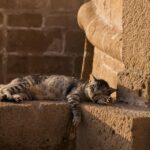Cats are fascinating creatures that have been companions to humans for thousands of years. However, many cat owners often find themselves questioning what is safe and nutritious for their feline friends to consume. Among the myriad of foods available, rice and pasta often come into play. This article will explore whether cats can eat these carbohydrate-rich foods and how they fit into a cat’s diet.
Understanding Feline Nutritional Needs
1. The Carnivorous Nature of Cats
Cats are obligate carnivores, meaning their diet mainly consists of meat. Unlike humans or dogs that can thrive on a varied omnivorous diet, cats have specific nutritional requirements:
- Protein: Cats need high levels of protein for energy and bodily functions. This protein primarily comes from meat sources.
- Taurine: This essential amino acid is crucial for heart health, vision, and reproduction. Unlike some animals, cats cannot synthesize taurine on their own, making it vital to include it in their diet.
- Fatty Acids: Essential fatty acids like arachidonic acid are also important for a cat’s well-being.
- Vitamins and Minerals: Cats require specific vitamins (like A and B) and minerals (like calcium and phosphorus) that they predominantly obtain from animal tissues.
2. The Role of Carbohydrates
In the wild, cats consume small amounts of carbohydrates, which come primarily from the stomach contents of their prey—mostly herbivores. While carbohydrates can provide energy, they should not be a significant part of a cat’s diet.
The ideal diet for cats should consist mainly of protein and fat, with carbohydrates making up a minimal part. As such, while your cat might not have an immediate adverse reaction to carbohydrates like rice or pasta, they don’t offer specific benefits compared to meat.
Can Cats Eat Rice?
1. Nutritional Value of Rice
Rice, particularly white rice, is a common food in many households. It is a source of carbohydrates and can provide some energy. However, it lacks many essential nutrients that cats need. The primary benefits of rice for cats include:
- Easily Digestible: Rice is often recommended for cats suffering from digestive issues, such as diarrhea, as it is gentle on the stomach.
- Low Allergenicity: Unlike some proteins, rice is less likely to provoke allergic reactions in cats.
2. When to Feed Rice to Cats
Despite its lack of essential nutrients, rice can be included occasionally in a cat’s diet under certain circumstances:
- Digestive Upsets: If your cat experiences gastrointestinal issues, a small amount of plain cooked rice may help soothe their stomach.
- Mixed with Meat: When combined with a protein source (like chicken or fish), rice can serve as a filler in homemade cat food or simply as an occasional treat.
3. Precautions When Feeding Rice
If you decide to feed your cat rice, keep the following precautions in mind:
- Moderation is Key: Rice should never make up more than 10% of your cat’s diet.
- No Seasonings: Always serve plain rice without any seasonings, oils, or sauces. Many flavorings can be harmful to cats.
- Monitor for Allergies: Watch for signs of allergies or gastrointestinal upset when introducing rice into your cat’s diet.
Can Cats Eat Pasta?
1. Nutritional Value of Pasta
Pasta, much like rice, is a source of carbohydrates. Common types of pasta, such as spaghetti and macaroni, also lack the essential nutrients cats need. They provide:
- Calories: Pasta is calorie-dense, which could lead to weight gain if fed in excess.
- Minimal Nutritional Benefits: While pasta contains some protein and B vitamins, these do not meet the needs of a cat.
2. When to Feed Pasta to Cats
Pasta can be offered to cats in very small amounts under particular conditions:
- Occasional Treat: A whimsical treat here and there may be acceptable.
- Mix with Meat: Just like rice, pasta should be mixed with a protein source to provide any nutritional value.
3. Precautions When Feeding Pasta
When considering feeding your cat pasta, keep the following precautions in mind:
- Choose Whole Wheat: If you must feed pasta, opt for whole wheat varieties, which provide slightly more nutrients than white pasta.
- Watch for Allergies: As with rice, ensure you monitor your cat for any adverse reactions to pasta.
- Portion Control: Limit pasta to a small amount, acknowledging its high carbohydrate content.
Health Risks of Feeding Cats Rice and Pasta
1. Obesity
One of the primary concerns when feeding carbohydrates to cats is obesity. Cats that consume excessive calories from carbohydrates and do not have an adequate opportunity for physical exercise can easily gain weight. Obesity can lead to a myriad of health issues, including diabetes, arthritis, and heart disease.
2. Digestive Issues
While rice can help soothe a cat’s upset stomach, a diet high in carbohydrates from rice or pasta may lead to constipation or other gastrointestinal problems. Cats require a high-protein diet to maintain a healthy digestive system.
3. Nutritional Imbalance
Feeding cats a diet that includes a high amount of rice and pasta could lead to nutritional imbalances. Without adequate protein and essential nutrients, your cat may suffer from deficiencies impacting their overall health and longevity.
What Should Cats Eat Instead?
1. High-Protein Diet
Cats thrive on protein-rich diets. High-quality commercial cat food is formulated to meet a cat’s nutritional needs and typically contains meat as the primary ingredient. Here are some good alternatives to rice and pasta:
- Canned Wet Food: This often contains high levels of meat and moisture, which cats benefit from.
- Raw Diet: Some owners opt for a raw meat-based diet, which mimics what cats would eat in the wild.
- Quality Dry Kibble: Look for dry food that lists meat as the first ingredient and is high in protein.
2. Fresh Meat
Unseasoned, cooked meat such as chicken, turkey, beef, or fish can be a great addition to your cat’s diet. Ensure it is well-cooked and free from bones, skin, or seasonings.
3. Limited Vegetables
While cats primarily require animal proteins, small amounts of certain vegetables can be beneficial. Options like cooked carrots or peas may be offered as occasional treats.
Signs of Dietary Issues in Cats
Observing your cat’s behavior and health is crucial. Here are some common signs that your cat may be having dietary issues:
- Vomiting or Diarrhea: Consistently vomiting or having loose stools may indicate dietary intolerances or digestive problems.
- Weight Changes: Unexplained weight loss or gain can signal an underlying issue.
- Lethargy: Decreased energy levels may point to nutritional deficiencies.
- Poor Coat Condition: A dull or sparse coat can indicate nutritional issues.
Conclusion
While cats can technically consume rice or pasta, these foods should only be offered in moderation and not as a staple of their diet. Cats are obligate carnivores that thrive on high-quality protein sources, and feeding them rice or pasta can lead to nutritional imbalances and health risks over time.
If you are ever unsure about your cat’s diet or concerned about their health, consult your veterinarian for tailored dietary advice. Keeping your feline friend healthy involves understanding their unique dietary needs, allowing you both to enjoy a long and fulfilling companionship. Adhering to a balanced, species-appropriate diet will help your cat live a happy, healthy life.
Frequently Asked Questions
1. Can cats be vegetarian?
No, cats are obligate carnivores and cannot thrive on a vegetarian diet. They require certain nutrients primarily found in animal tissues, such as taurine.
2. What are some safe treats for cats?
Safe treats for cats often include cooked meats (like chicken or turkey), catnip, and specific cat treats formulated for their dietary needs.
3. How can I introduce new foods into my cat’s diet?
Introduce new foods gradually, offering small amounts, and observe your cat for any adverse reactions. Transitioning too quickly can lead to digestive upset.
By adhering to these guidelines and being conscious of their dietary needs, you can ensure your cat enjoys a nourished, happy life, free from the worries of unsuitable foods.
Featured Image Credit: Pixabay


